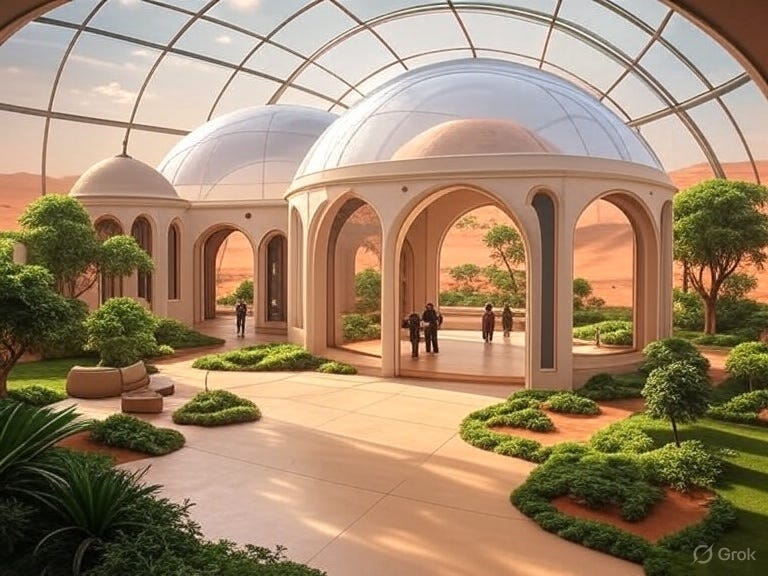In a not-so-distant future, when humanity dreams of establishing permanent colonies on Mars, the inspiration could come from an unexpected place: the Arabian Peninsula. This region, known for its vast deserts and extreme temperatures, is demonstrating that it is possible to transform hostile environments into habitable paradises. Could the development model of cities like Dubai, Neom, or The Line be the blueprint for life on the Red Planet?
The Boom of Development in the Arabian Peninsula
The Arabian Peninsula has experienced an unprecedented transformation in recent decades. Countries like the United Arab Emirates (UAE), Qatar, and Saudi Arabia have turned arid deserts into modern and vibrant metropolises. Dubai, for example, has gone from being a modest fishing port to a global city with iconic skyscrapers like the Burj Khalifa, gigantic shopping centers, and cutting-edge tourist attractions. Qatar, with its capital Doha, has invested in world-class infrastructure, especially evident during the 2022 FIFA World Cup. And now, Saudi Arabia is pushing ambitious projects like Neom and The Line, futuristic visions that promise to redefine urban life.
Before this economic boom driven by oil and diversification, the region was little more than an inhospitable desert. It still is for the most part, with temperatures exceeding 50°C in summer and sandstorms that make outdoor life a constant challenge. From the perspective of those of us who live in temperate climates, like in Europe or the United States, the idea of inhabiting a desert seems terrifying: water scarcity, exposure to extreme heat, and geographic isolation. Historically, survival in these environments has been an achievement of nomadic Bedouins, but never an attractive option for large populations.
However, these countries are changing that narrative. They are attracting millions of people not just as tourists, but as permanent residents. The secret lies in a "enclosed" but luxurious lifestyle: buildings with constant air conditioning, climate-controlled shopping malls, luxury hotels, vehicles with refrigeration systems, and even indoor ski slopes in the middle of the desert. Contact with the outside is minimized, turning the desert into a mere backdrop. More and more people are drawn to this promise of comfort and opportunities, proving that technology can make the uninhabitable habitable.
The Connection with Mars Colonization
And what does all this have to do with Mars? A lot, actually. One of the biggest obstacles to colonizing the Red Planet is not just technological—like interplanetary travel or oxygen production—but human: how to attract people to want to live there permanently?
Mars is an extreme desert raised to the nth power: temperatures ranging from -60°C to -140°C, a thin atmosphere without breathable oxygen, lethal solar radiation, and global dust storms. Any Martian colony would require humans to live "enclosed" in pressurized habitats, possibly underground or in sealed domes, with outdoor excursions limited to spacesuits. This could create a deep psychological problem: humans, by nature, seek pleasure, natural beauty, and freedom. Living on Mars could be perceived as a punishment, a voluntary exile where the reward is returning to Earth.
Imagine the family dilemma: a pioneer might be willing to sacrifice their life for the adventure of Mars, but would they condemn their children to grow up in caves or confined modules, never feeling the earthly wind or seeing an ocean? It's likely that many would think twice, or that future generations would demand to return to Earth, putting the long-term viability of any colony at risk. Without a stable and motivated population, the Martian dream would fade away.
Models of Enclosed Life: Lessons from the Desert
This is where the hope from the Arabian Peninsula comes in. Projects like Neom in Saudi Arabia—a 170 km-long smart megacity—and The Line—a 170 km car-free linear structure powered by renewable energy—are proving that living "enclosed" doesn't have to mean suffering. These futuristic cities prioritize technology to offer an exceptional quality of life: hyper-fast transportation, artificial green spaces, immersive entertainment, cutting-edge healthcare, and digitally connected communities. All of this in a desert that, like Mars, is hostile on the outside.
If these models succeed, they could inspire Martian habitats where indoor life is so attractive that the outside becomes irrelevant. Imagine colonies with virtual reality simulating earthly beaches, gyms with artificial gravity, hydroponic farms producing fresh food, and interplanetary social networks to maintain emotional connections. The Arabian Peninsula is experiencing unprecedented human development, fusing technological innovation with urban design, and could export this expertise to Mars.
A Future Where Launches Depart from the Desert
Ultimately, this adaptation to the desert could make residents of Dubai, Qatar, Neom, or Riyadh the ideal colonists for Mars. Accustomed to controlled and climate-regulated environments, they would be better prepared for life in underground or pressurized colonies. Why not imagine space shuttles launching from these cities, instead of traditional sites like Boca Chica in Texas? With growing investments in space technology—like the UAE's agreements with agencies such as NASA—and a population already adapted to the "impossible," the Arabian Peninsula could become the hub for Martian exploration.
The colonization of Mars won't just be about rockets and robots; it will be about making humanity want to stay. And in that, Earth's deserts might have the last word. If Dubai can turn sand into gold, why couldn't Mars become a desirable new home?













Share this post